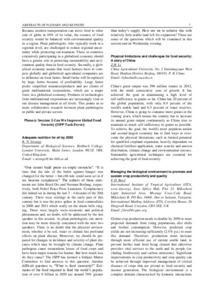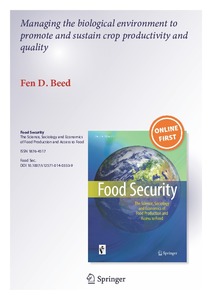| dc.contributor.author | Beed, Fen D. |
| dc.date.accessioned | 2019-12-04T10:58:24Z |
| dc.date.available | 2019-12-04T10:58:24Z |
| dc.date.issued | 2014 |
| dc.identifier.citation | Beed, F. (2014). Managing the biological environment to promote and sustain crop productivity and quality. Food Security, 6(2), 169-186. |
| dc.identifier.issn | 1876-4517 |
| dc.identifier.uri | https://hdl.handle.net/20.500.12478/984 |
| dc.description | Early view |
| dc.description.abstract | Global crop production needs to double by 2050 inorder to meet demands from rising populations, diet shifts andbiofuels. Production must increase through more efficient useof currently available arable land to prevent encroachment onland that otherwise provides vital services to the earth and itspeople (i.e. through increased biodiversity and reduced carbonemissions). Significant improvements can be realised throughenhanced management of critical diseases of crops that arepivotal to food security and income generation. To achievethis, the dynamic and complex interactions between crops andbeneficial or antagonistic organisms that characterise the biologicalenvironment, must be understood. For Sub-SaharanAfrica (SSA) a crop healthcare system is required that encompassesnational responsibility and regional cooperation, andwhich harnesses global excellence in terms of the knowledgeand methods that are available for implementation. This systemwould be able to control crop diseases in a pre-emptiveand cost efficient manner and avoid the current scenario ofbelatedly combating largescale epidemics. Componentswould include: risk assessment to predict impacts on foodand feed value chains; targeted surveillance; fit-for-purposediagnostics; control intervention packages; extension mechanisms;and enabling policy environments. Each componentwould be refined, based on practical feedback and results fromresearch targeted to address knowledge gaps. Specific examplesare presented for viruses of cassava, viral and bacterial diseasesof banana, stem rust of wheat and a new viral disease complexof maize. Finally, the links among disease control and improvedcrop quality, consumer health and safe trade are discussedthrough biological control interventions for aflatoxin in SSA. |
| dc.format.extent | 169-186 |
| dc.language.iso | en |
| dc.subject | Aflatoxins |
| dc.subject | Organisms |
| dc.subject | Plant Pathology |
| dc.subject | Surveillance |
| dc.subject | Productivity |
| dc.title | Managing the biological environment to promote and sustain crop productivity and quality |
| dc.type | Journal Article |
| dc.description.version | Peer Review |
| cg.contributor.affiliation | International Institute of Tropical Agriculture |
| cg.coverage.region | Africa South Of Sahara |
| cg.isijournal | ISI Journal |
| cg.authorship.types | CGIAR single centre |
| cg.journal | Food Security |
| cg.howpublished | Formally Published |
| cg.accessibilitystatus | Limited Access |
| local.dspaceid | 77913 |
| cg.identifier.doi | https://dx.doi.org/10.1007/s12571-014-0333-9 |


